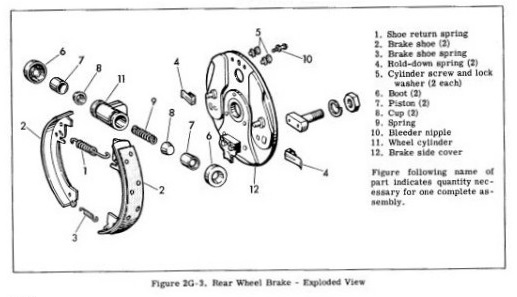You are using an out of date browser. It may not display this or other websites correctly.
You should upgrade or use an alternative browser.
You should upgrade or use an alternative browser.
Sorry you are dead right Greg, you only need one piston with a sliding cylinder. But my point really was that the technology was there in the 30's to go hydraulic with drums but no manufacturer deemed it possible to miniaturise the system for bikes. Was it only when discs came out that hydraulics appeared on bikes?
Oops Bruce we crossed over. So how about a adapting those for your Vincent?!
Last edited by a moderator:
I don't know exactly when hydraulics appeared successfully on bikes. I suspect most Vincent owners would not want the "looks".

Although, I thought that hydraulic cables might have some appeal:

Vincent brakes, not having anchor tabs, are a little more difficult to accommodate. I would think that the twin leading shoes might be a better candidate for hydraulics.

It surprises me how little engineering information seems to be available on mechanical drum brakes considering how long they were used on bikes.
David
Although, I thought that hydraulic cables might have some appeal:
Vincent brakes, not having anchor tabs, are a little more difficult to accommodate. I would think that the twin leading shoes might be a better candidate for hydraulics.
It surprises me how little engineering information seems to be available on mechanical drum brakes considering how long they were used on bikes.
David
Oops Brice we crossed over. So how about a adapting those for your Vincent?!
A Harley part on my Vin?
Didn't someone like Nuvolari when asked how to go faster said 'brake less'I always tell everyone that "They go better than they stop"...............
I had thought about the Duo-servo option but lacked the bravery to try it. The point made in the first post is that with Duo-servo the first shoe applies it's effort to the leading edge of the second shoe and all of the load is transferred onto the cam at the trailing edge of the second shoe.
Concerns about the strength of the cam are valid but what you are actually doing is using the servo effect to push against the cam which you are then trying to turn against the cable and hand lever. You are not actually getting the servo effect.
Any duo-servo brake that I have seen does use a dual piston cylinder but only the lead piston, in whichever direction you happen to be going, actually does anything. There is always a mechanical stop that the trailing end can abut against once it has closed the trailing piston right in. The stop is the round thing above the cylinder in the picture.
Concerns about the strength of the cam are valid but what you are actually doing is using the servo effect to push against the cam which you are then trying to turn against the cable and hand lever. You are not actually getting the servo effect.
Any duo-servo brake that I have seen does use a dual piston cylinder but only the lead piston, in whichever direction you happen to be going, actually does anything. There is always a mechanical stop that the trailing end can abut against once it has closed the trailing piston right in. The stop is the round thing above the cylinder in the picture.
Attachments
Didn't someone like Nuvolari when asked how to go faster said 'brake less'
Fangio!
David


